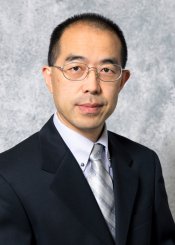Editor’s note: Professor An relocated to SDSU from Washington State University Nov. 3, 2014, to serve as the inaugural Markl Faculty Scholar in Cancer Research.

The An research lab focuses on genomics. The human genome has all of the instructions necessary for one’s 30 trillion cells to function correctly.
When mutated, the genome is also unfortunately responsible for myriad genetic disorders. The source of such mutations can be external, such as from exposure to UV rays or carcinogens.
Another important source of mutations is from within the genome. About half of the human genome is made of "jumping genes," which are DNA sequences capable of moving from one genomic location to another. The An lab focuses on a specific class of jumping genes, the long interspersed element type 1 (LINE-1; L1 for short).
Not too long ago, it was thought that most L1 jumping occurs in the germline (i.e., takes place in germ cells and are heritable). However, extensive L1 jumping has been recently discovered in cancer patients using high-throughput sequencing.
Approximately 35% of all cancer samples had at least one "somatic" jumping event (i.e., only tumor cells are affected). Esophageal, lung, head and neck and colorectal cancers showed the highest jumping activities (i.e., carrying >10 L1 insertions per tumor sample). The detection of somatic insertions in histologically normal tissues from cancer patients also raises the prospect of somatic jumping in a healthy individual.
In this context, the An lab's overarching research goals are (1) to uncover mechanisms that regulate L1 jumping, (2) to define roles and consequences of L1 jumping in human health, and ultimately (3) to devise interventional strategies that target undesired L1 activities and promote human health.
An has a track record of developing innovative cell and mouse models to tackle these important biological questions. The An lab is one of only a few groups globally that are specialized in using genetically engineered mouse models to investigate L1 activities during animal development in both somatic and germline tissues.
The An lab has recently been supported by a generous endowment from college alumni Barry and Sharon Markl and grants from the Eunice Kennedy Shriver National Institute of Child Health and Human Development, National Institute of General Medical Sciences and National Institutes of Health Office of the Director. A concerted effort from An's research team has led to several important discoveries toward its research goals.
For more information, please visit An Lab Research.
- Contact:
- Telephone number: 605-688-4767
Republishing
You may republish SDSU News Center articles for free, online or in print. Questions? Contact us at sdsu.news@sdstate.edu or 605-688-6161.

